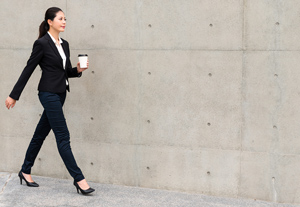Knocking Off The Rust
Getting Ready For The Post-COVID Business World
by Heather Kluter
-
Life feels like it may be returning to normal, as mask mandates continue to lift and social gatherings increase.
No one knows for sure how long these lifts will last—or if some of those restrictions may return from time to time—but many of us are continuing to increase our return to in-person normalcy. Some people are raring to go and cannot wait to get back to pre-COVID social settings, while others have grown quite comfortable with being ‘remote’ and are still very anxious about coming back together in person.
While we should be mindful that these returns are immensely personal, how do we dust off our rusty social skills to ensure we are ready for our re-entry into a post-COVID business world? ‘Social rust’ is to be expected after dealing with the uncertainty of the pandemic. Activities that we never thought twice about may now feel awkward or anxiety-inducing. Even those who are willing to step back into live social situations may still want to adhere to some social boundaries.
So, to ease back in socially, maybe we should start off gradually. Humor can help in these situations. When suggesting an in-person meetup, try keeping it light: “I’d love to meet you for coffee or lunch, is this your jam, yet?” This gives someone an out if they still aren’t comfortable meeting in person and lets them know a decline will cause no hard feelings and that you recognize that not everyone is comfortable coming together in person yet.
For business meetings, starting slowly could mean inviting just one or two people, before diving back in, full-scale, to larger groups. Meeting invitations should clearly let the recipient know how many people have been invited, where the meeting will take place, and other details that recipients may be concerned with, such as whether you’ll be meeting outside because not everyone will be vaccinated (or because not everyone is willing to reveal their vaccination or health status)—or whether you’ll be sitting together, but at an acceptable distance. As mask mandates ease, you can more easily address mask-wearing on a smaller level, when just one or two people are invited.
Once someone agrees to meet, greetings can also be established ahead of time, again to set potential attendees at ease and alleviate the awkwardness that can come when trying to greet one another spontaneously in person. If shaking hands is no longer an option, consider using humor to offer alternatives like, “When we meet, let’s skip the handshake. We don’t have to chest-bump. but feel free to offer a wave, flash a peace sign, or tip your imaginary hat, instead of shaking hands.”
As you ease into larger gatherings, continue being yourself to set others at ease. Recognizing that for many, this may be their first post-COVID gathering, you can let guests know that any and all awkwardness is expected and welcome. Giving guests some guardrails will help them ease back in. It’s like my mother always used to tell me, “The rules of manners exist to help make others feel more comfortable and to show that you care about them.” Now is a better time than ever, perhaps, to help people find comfort and care in gathering. Continue to assess the comfort level of guests and to offer meeting plans aligned with the needs of your least comfortable invitee. Eventually, for larger meetings, mask-wearing will likely become trickier. It will be key to address mask-shaming and let attendees know that mask-wearing at your meeting is a personal decision that will be respected, whether a person’s choice is to wear a mask or not (assuming mask mandates have been lifted where the meeting will take place). Even still, try to provide a virtual option for attendees who are still uncomfortable with attending gatherings where some may not be wearing masks.
As an insights firm, clients have been asking us for at least a year about the return to in-person research. Can it be done? The short answer is yes, we have returned, but with some changes that are hopefully embraced as enhancements.
- Physical distancing is key to helping clients and respondents feel comfortable and safe. Research facilities, for example, have been upgraded to include acrylic barriers, where necessary. Conference rooms have been reconfigured to ensure appropriate distancing between respondents and the moderator. Group sizes, in some cases, may now be smaller, depending on room size and configuration.
- Food that is served to clients and respondents is now individually ordered and packaged. The use of disposable utensils is also now the norm.
- Many research facilities have installed hands-free doors, sinks, and other features to decrease the surfaces that must be touched. In addition, facility cleaning, with a focus on high-touch areas, has been greatly enhanced.
- Screening of respondents and clients in accordance with CDC guidelines also allows all guests to feel at greater ease. This could include mandating mask-wearing and assessing vaccination status, as well as having a policy allowance for time off when individuals have contracted or been exposed to COVID-19. Any respondent with any suspicious symptoms is screened out.
When it comes to ethnography, we began conducting virtual interactions far before the pandemic, due to client needs for speed and cost savings. However, our preference for in-person ethnography remains. Your obligation to the research participant is primary; being open and honest about your research goals is perhaps now more important than ever. Establishing trust during ethnography is critical and there is an ethical dimension to this relationship that must always be respected. The potential anxiety stemming from COVID requires researchers to work even harder now for ensuring a fruitful interaction.
With ethnography, you are also on the respondent’s turf, so what they say goes (of course in adherence to local mandates). Consent should be ongoing and the participant should be kept aware of any major changes that might affect their participation in your research. Even before the pandemic, it was best practice not to drag along an army of viewers; that is even more crucial now. We must also agree upon criteria for staying healthy during our interactions. These topics could include mask-wearing, knowledge of vaccination status, possible interaction with anyone having COVID, handshaking, distancing, sanitizing, means of travel, and food-/equipment-sharing, among other considerations. For our automotive projects, for example, we have had to find ways to safely integrate ourselves into the home lives and passenger seats of a variety of new-vehicle shopper segments, in order to explore concept fit and driving/buying experiences. We also kept our eyes on them after we went away, with cameras mounted in their vehicles for an extended period of time, to further capture their spontaneous thoughts and feelings while using their vehicles.
Throughout the pandemic, Decision Analyst has used our strong connection to consumers to better understand the current experience, as well as future expectations of consumer life. We’ve also measured consumer emotions and wellbeing and have mapped six fascinating COVID-related consumer-mindset segments that could impact your business. For fun, complete our Consumer Mindset Typing Tool (based on the average U.S. consumer in each mindset) and see which segment you are in.
No one can know for sure when life will return to normal, because what’s considered normal continues to change. Nevertheless, with patience, respect for others, and an optimism in a silver lining and a plan B to carry us through, we can all slowly dust off a little of the social rust we’ve acquired over the past two years and be ready for the post-COVID business world.
About the Author
Heather Kluter (hkluter@decisionanalyst.com) is a Senior Vice President at Decision Analyst. She may be reached at 1-800-262-5974 or 1-817-640-6166.
Copyright © 2024 by Decision Analyst, Inc.
This posting may not be copied, published, or used in any way without written permission of Decision Analyst.



